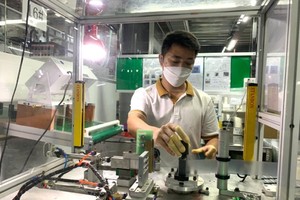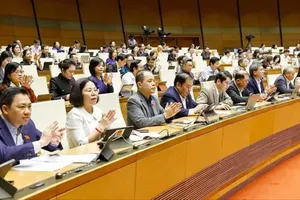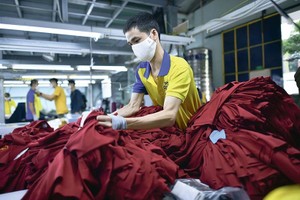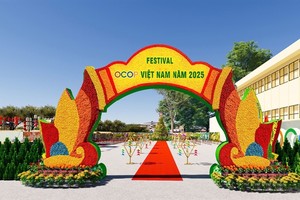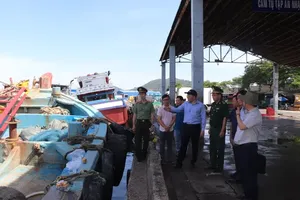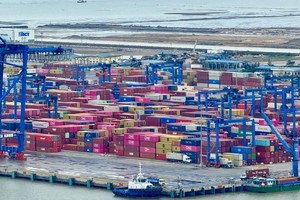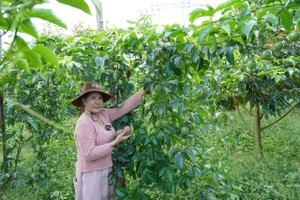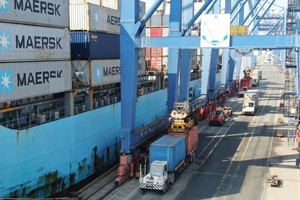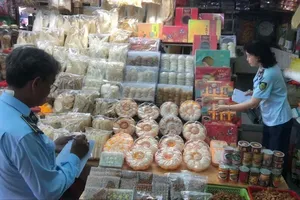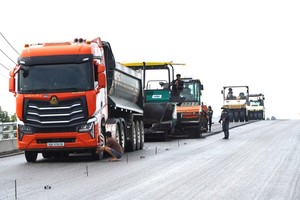 |
The Cai Lon - Cai Be irrigation system has contributed to preventing saline intrusion from the West Sea. (Photo: SGGP) |
Resolution 120 has truly brought a new wave of development to the Mekong Delta. In addition to identifying the prioritized agricultural production sectors in the order of aquaculture, fruit trees, and rice, many resources have been invested in the Mekong Delta to cope with the issues caused by climate change.
Minister of Agriculture and Rural Development, Le Minh Hoan, stressed the importance of connecting the 13 provinces and cities in the Mekong Delta through the implementation of Resolution 120 on the development of the Mekong Delta with climate change adaptation.
The Mekong Delta region comprises four ecological zones, namely Dong Thap Muoi, Long Xuyen Quadrangle, Ca Mau Peninsula, and coastal provinces, and each sub-region is an economic entity. Minister Hoan emphasized that linking these sub-regions should not be limited to administrative space but should go beyond that to consider a larger spatial dimension.
The Mekong Delta needs a stronger link with Ho Chi Minh City
Minister of Agriculture and Rural Development, Le Minh Hoan, believes that when the economic space expands, the production scale will follow suit. This will enable the diversification of industries and operations within the economic space. Professor Dr. Vo Tong Xuan shares the same viewpoint, stating that Resolution 120 of the Government has come at a timely moment, allowing the Mekong Delta to adapt proactively to the growing threat of extreme weather.
"I am pleased to see the shift towards reducing the area of multi-crop rice cultivation. The coastal saline area has made impressive progress, with around 200,000 hectares of rice-shrimp production. During the rainy season, they plant rice, and when it stops raining, they switch to raising shrimp. However, there is still a need for even stronger transformation," said Prof. Dr. Vo Tong Xuan.
He suggested that localities should implement policies to accelerate the linkage between farmers and businesses in the agricultural production chain. In particular, the Mekong Delta needs to have closer connections with Ho Chi Minh City to create more open markets for agricultural products.
Resolution 120 has actually brought a breath of fresh air to the Mekong Delta. In addition to implementing crop rotation and prioritizing fisheries, fruit trees, and rice, significant resources have been invested to mitigate the impacts of climate change. The government has allocated over VND10,000 billion to address coastal erosion and renovate irrigation systems for rice and shrimp farming areas.
The investment strategy for irrigation involves a combination of hard and soft solutions: rice is grown where there is enough fresh water, and aquaculture is carried out in brackish and saltwater areas. At least 300,000 hectares of agricultural land have benefited from the newly installed irrigation systems.
According to the Ministry of Planning and Investment, the total state budget support for projects in the Mekong Delta is expected to reach around VND266 trillion between 2021 and 2025, up 20 percent compared to the 2016-2020 period. This includes a local budget balance of about VND162 trillion, a central budget of about VND82 trillion, and foreign capital (ODA) of VND22 trillion.
Moreover, the State budget will invest capital through the Ministry of Transport, the Ministry of Agriculture and Rural Development, and other agencies to deploy works and projects in the Mekong Delta region, which will reach about VND121 trillion.
The above-mentioned capital has been allocated to the completion of various key projects, such as the Trung Luong-My Thuan-Can Tho Expressway, Can Tho-Ca Mau Expressway, regional traffic routes, and several national highways in the region, including national highways 30, 53, and 57.
Additionally, the capital has contributed to the construction of infrastructure projects, such as the runway No.2 of Phu Quoc Airport, Rach Mieu No.2 Bridge, My Thuan No.2 Bridge, Dai Ngai Bridge, My An-Cao Lanh route, An Huu-Cao Lanh route, and Chau Doc-Can Tho-Soc Trang route.
Mr. Huynh Ngoc Nha, Director of the Department of Agriculture and Rural Development in Soc Trang Province, stated that after more than five years of implementing Resolution 120, it is evident that this resolution has had a profound and positive impact on many aspects of life and society in the Mekong Delta.
In Soc Trang, all levels of government, businesses, and especially people have exhibited creativity and initiative to adapt to climate change. Many successful models and initiatives have been implemented and replicated in the province, progressively establishing sustainable livelihoods for those living in areas susceptible to the effects of climate change.
Grasping the golden opportunity
Regarding Resolution 120, Ms. Carolyn Turk, the World Bank Director in Vietnam, believes that the Mekong Delta is an exemplary model of the government's transformative thinking and approach to sustainable development. Along with high expectations comes great responsibility to turn that mindset and approach into reality and success, not only for the nearly 20 million people in the region but also as a source of inspiration and a model for regional development.
Ms. Carolyn Turk states that Resolution 120 has made a breakthrough in terms of sustainable development by shifting from a reactive approach to climate change to a proactive one of coexisting with nature.
Many experts have also noted that the impacts of climate change, such as rising sea levels, extreme weather, and saltwater intrusion, are being addressed proactively and are gradually becoming the "new normal" in the Mekong Delta. Local authorities and communities have started to change their thinking, vision, and approach to regional development and planning. Many countries and organizations worldwide have committed to supporting the Mekong Delta in this natural farming process.
According to MSc Nguyen Huu Thien, an expert on the ecology of the Mekong Delta, natural farming does not mean doing nothing. Instead, it is about understanding and respecting the laws of nature and avoiding harsh interference with it. The essence of Resolution 120 is to recognize saltwater, brackish water, and freshwater as resources and a top priority.
In the past, rice was the primary crop, followed by fruit trees, vegetables, and aquatic products. However, now, the top crop is aquatic products, followed by fruit trees, and rice is in third place. This shift accurately reflects and highlights the agricultural economic potential of the Mekong Delta.
Resolution 120 also highlights the significance of planning. Recently, the Government approved the Mekong Delta Plan for the period 2021-2030, with a vision to 2050 (approved by the Prime Minister in Decision No. 287/QD-TTg dated February 28, 2022). This marks the first time a regional plan has been issued under the Planning Law, showcasing "new thinking, new vision, new values, new opportunities" for the future development of the Mekong Delta, particularly in the context of climate change adaptation.
Local authorities and scientists agree that Resolution 120, the Integrated Master Plan for the Mekong Delta region, and Resolution No. 13-NQ/TW of the 13th Politburo on the direction of socio-economic development, ensuring national defense and security in the Mekong Delta until 2030, with a vision to 2045, present a golden opportunity for the Mekong Delta to achieve sustainable development.
MSc Nguyen Huu Thien, an expert on the ecology of the Mekong Delta:
Leverage for the Mekong Delta to take off
In the integrated planning, emphasis has been placed on the formation of agricultural hubs (aquaculture, fruit, rice, and logistics) located in localities such as Ben Tre, Dong Thap, An Giang, Kien Giang, Ca Mau, Can Tho, and Hau Giang. These hubs will have research, processing, and preservation centers, and create consumption channels for agricultural products. Formed and under-construction arterial highways and regional connecting roads that connect these agricultural hubs will become the leverage for the Mekong Delta's future takeoff.
Mr. Nguyen Van Tam, former Director of the Department of Agriculture and Rural Development in Kien Giang:
Balancing infrastructure and non-infrastructure solutions
There were two opposing views before the construction of the two largest sluices, Cai Be - Cai Lon, in the Mekong Delta. On one hand, some argued that since 2018, people in U Minh Thuong and the Ca Mau Peninsula areas have already adjusted their crop structures and adapted well to climate change, and saltwater has become a resource rather than a threat.
If it is no longer a threat, why build a sluice? However, after the sluices were put into operation, there were localized shortages of saltwater for some shrimp farming areas after the rice crop, but these were dealt with satisfactorily. This shows that construction solutions are still fundamental. Concerning natural disasters, we must be as proactive as possible. Natural farming does not mean doing nothing, but doing things properly, on a large scale, sustainably, and with the least possible impact on nature.
